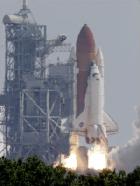|
|
|
Tuesday, July 26, 2005
Discovery Lifts Off.

CAPE CANAVERAL, Fla. — Discovery blasted off Tuesday morning to send
seven astronauts into partly cloudy skies above Florida on the first
space shuttle flight since the Columbia disaster 2 1/2 years ago.
The shuttle lifted off from the launch pad at Cape Canaveral promptly at
10:39 a.m. EDT to begin a 12-day supply and repair mission.
While in orbit, Discovery's crew will inspect the most vulnerable areas
of the spacecraft, using a new 50-foot, laser-tipped boom. They also
will practice repairing samples of deliberately damaged thermal tile and
panels.
During an early morning meal, crew members sported matching Hawaiian
shirts. They smiled for a NASA television camera as astronaut Steve
Robinson strummed a guitar. Later in the morning, they waved and gave a
thumbs-ups as they walked to the van that took them to the launch pad.
Before boarding the shuttle, astronaut Soichi Noguchi held up an orange
piece of paper made to look like an oversized card from the board game
Monopoly that read "Get Out of Quarantine." The astronauts have been
isolated for much of July to keep them from getting sick. Astronaut
Charles Camarda held up several signs for his family, including one that
read, "Be Good for Mom."
This was the second time the astronauts made the trip to Discovery for a
planned liftoff. On July 13, the astronauts were loaded onto the shuttle
before the day's launch was srubbed because of a faulty sensor reading.
On Tuesday, the fuel sensors on Discovery's giant external tank passed
initial tests early. NASA officials monitored the sensors throughout the
three-hour fueling process to make sure they functioned properly.
"All the sensors are performing as expected," said NASA commentator
Jessica Rye.
If the equipment trouble reappeared, NASA was prepared to bend its
safety rules and press ahead with the launch anyway with just three of
the four sensors working.
Only two sensors are needed to do the job. But ever since NASA's return
to space in 1988 after the Challenger explosion, the space agency has
decreed that all four have to work.
NASA Administrator Michael Griffin called such a deviation from the
rules "an acceptable risk."
"Actually, it's quite a low one," Griffin told The Associated Press on
Monday.
The fuel sensors are designed to prevent the main engines from running
too long or not long enough, in case the fuel tank is leaking or some
other major breakdown occurs. An engine shutdown at the wrong time could
prove catastrophic, forcing the astronauts to attempt a risky emergency
landing overseas, or leading to a ruptured engine.
After Discovery's launch, NASA will take a look at changing the rule to
require only three functioning sensors under certain circumstance,
Griffin said.
Over the past few days, NASA rewired two of the sensors to try to
diagnose the trouble and repaired faulty electrical grounding aboard
Discovery in hopes that would solve it. But the space agency was unable
to fully explain the faulty reading.
"We have addressed everything we know on the shuttle that can go wrong
that we have the technology to fix," Griffin said. "Some things simply
are inherent to the design of the bird and cannot be made better without
going and getting a new generation of spacecraft."
But a retired agent in NASA's inspector general office, Joseph Gutheinz,
said the space agency does not appear to have learned its lesson with
Columbia. Accident investigators criticized NASA's tendency to downplay
risks and discourage engineers from speaking up.
"It is clear to me that NASA continues to put mission over safety,"
Gutheinz said. "I fear that if NASA is wrong this time, as they were for
Apollo 1, Challenger and Columbia, manned space missions may be halted
for a very long time in the United States."
The launch promised to be not only an appraisal of changes in NASA's
safety culture, but also a test of the fuel tank that was redesigned
after the Columbia disaster to minimize the chances of debris falling
off.
Columbia's fuel tank lost a large chunk of foam insulation at liftoff.
The debris slammed into the left wing, smashing a hole that proved
catastrophic during re-entry Feb. 1, 2003. All seven astronauts were
killed.
NASA removed the responsible section of foam and installed heaters in
its place to prevent ice buildup from the super-chilled fuel, since
flying ice can be as lethal as foam debris. Engineers added a heater in
another ice-prone spot on the tank, and a special crew planned to make
extra checks for fuel-tank ice during the final portion of the
countdown.
A few family members of the fallen Columbia astronauts planned to return
for the second launch attempt. The VIP list was topped by first lady
Laura Bush and Florida Gov. Jeb Bush, her brother-in-law.
Source: Fox News
The Associated Press contributed to this report.
|
|